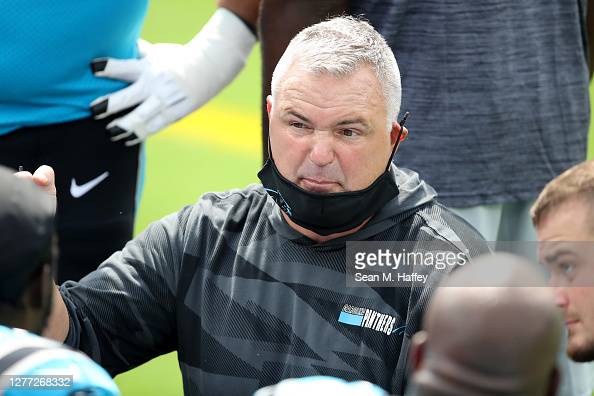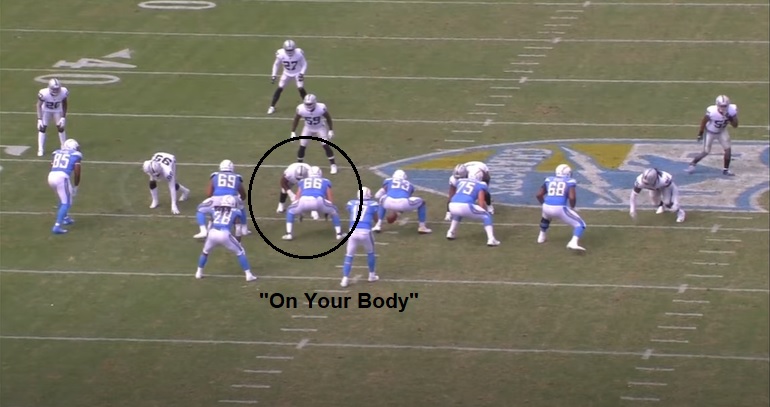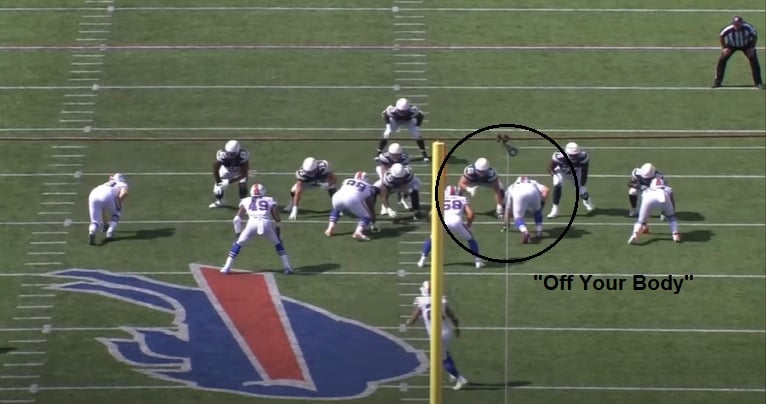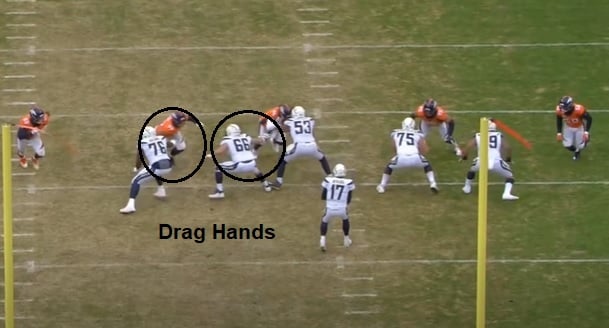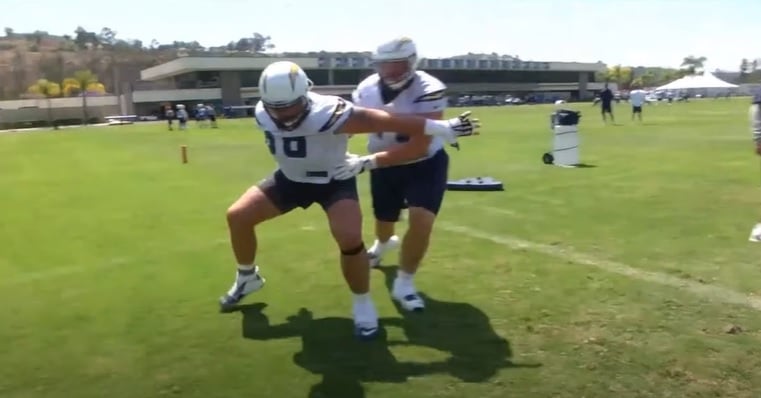I was in the same boat as the rest of Steelers’ Nation. When the Pittsburgh Steelers tabbed Pat Meyer to be their new offensive line coach, my first question was Who is Pat Meyer?
No, the Steelers couldn’t snag Doug Marrone or bring Mike Munchak back to Pittsburgh. Anyone outside of those two names elicit the reaction the Meyer hire has. Groans. There’s also pointing to a recent track record of mixed results in Los Angeles and Carolina. Decent run success rates, higher sack totals, especially with the Panthers, where Meyer was let go from after the 2021 season.
But even using those stops to gauge Meyer’s ability to coach is difficult to do. Munchak could get hired in Pittsburgh and if they trotted five of me on the field, whoever the quarterback is will die on the field. It doesn’t matter how well Munchak coaches things. Talent, injuries, how the front office builds out its roster, what your OC wants, and a half-dozen other variables all go into how good the finished product looks like.
In trying to evaluate Meyer, what matters most of all is what he believes. That’s coaching. Teaching a belief system onto the players. What Meyer cares about is going to help dictate the type of line the Steelers have and what assignments they’ll carry out. So my goal was to try to figure that out.
I don’t have all the answers but went through articles, videos, and clinics to find out what Meyer coaches. The most important tool I found was this 2020 Deleone Baylor coaching clinic Meyer virtually attended just months after being hired as the Panthers’ offensive line coach. It’s 71 minutes long and focuses almost entirely on pass protection but Meyer walks through sets, drills, tips/tricks, and overall philosophy of pass protection. It’s a great resource to learn the man, the coach, and what to expect in Pittsburgh. Let’s dive in.
Before we get into the X’s and O’s of pass protection, a couple lighter points.
As he’ll explain why in his clinic, Meyer prioritizes length and measurables. He likes big, strong players with long arms. In a Riot Report interview with him after coaching in the 2021 Senior Bowl, Meyer laid out the things he looks for in his front five.
“Typically, when I look at it, I have traits that I look for in linemen. Measurables; how long are they? Does this guy have huge length, does he have 35” arm length and this guy has a 33” arm length? You look at the measurables but then you look at the traits and try and find if he can he anchor down? Is this guy powerful? How does this guy stand? What’s his lower body stiffness like?”
Now, we should match that to what teams Meyer has coached for have actually done. As the Chargers’ o-line coach from 2017 to 2019 and Panthers’ o-line coach from 2020 to 2021, here are the arm lengths of the players drafted.
Brady Christensen: 33 1/4
Deonte Brown: 32 3/8
Forrest Lamp: 32 1/4
Dan Feeney: 33 3/8
Sam Tevi: 34
Scott Quessenberry: 31 3/4
Trey Pipkins: 33 7/8
To be fair, that’s not a “long” group of guys. I’d say they are bigger/stronger types which tracks with Meyer saying if guys can “anchor down” but these guys generally have average to even a little below average length for the position. Meyer isn’t hand-picking these guys but the comments don’t completely match their draft picks. Who, by the way, aren’t exactly the most impressive list of guys who have developed into quality players, though Meyer spent just three years in LA and two in Carolina with both of the Panthers’ picks coming in 2021. So he wasn’t around long-term to fully develop guys (of course, a lack of development may have gotten him shown the door in the first place).
Let’s also quickly look at his resume. Meyer has been a longtime football coach after playing as an offensive lineman at Colorado State and briefly seeing time with the Arizona Cardinals and AFL St. Louis Stampede. His first coaching job came as a grad assistant/tight ends coach at Memphis in 1997, one year after Mike Tomlin left there. He became the Tigers’ strength & conditioning coach in 1999 before taking on the same role at NC State in 2000. There, he worked his way up the ladder and oversaw the entire NC State S&C program late in his time there. He was also named the Wolfpack’s o-line coach in 2006, his last year with the team. He worked with Philip Rivers throughout his career but left after the 2006 season when the head coach got fired and Tom O’Brien was brought in for 2007.
He spent a year at Florida State as their S&C coach before returning to the offensive line, coaching at his alma mater from 2008 to 2011 at Colorado State. He was named offensive coordinator in 2011. He spent the next year in the CFL as the Montreal Alouettes’ OC for the 2012 season and followed Marc Trestman to Chicago for his two years with the Bears. He was hired by the Buffalo Bills as an offensive consultant for the 2015 and 2016 seasons before being hired by the Chargers in 2017 and the Panthers in 2020.
I do like the many perspectives he’s had as a coach: strength and conditoning (working with many players, problem solving, understanding body types), offensive line coach, offensive coordinator (seeing the whole offensive picture), and tight ends coach. That doesn’t guarantee success but I like hiring a guy who has sort of done it all and has a wide lens of how an offense and team works.
Coaching is a fraternity and Meyer said he is good friends with Aaron Kromer, one of the league’s better o-line coaches hired by the Buffalo Bills this year. Meyer says he’s gotten a lot of his ideas from guys like Kromer, Bill Callahan (the great o-line coach of the Browns) with run game influence from the likes of Howard Mudd and Jim McNally. Run game wasn’t discussed much here but Mudd and McNally seem to have more of an inside zone/tight zone background.
From an X’s and O’s standpoint, in the clinic I watched, Meyer preached aggressiveness. That’s common in the run game but we hear less about aggressiveness in pass protection. But Meyer held that idea higher than all others.
To sum it up. Late in his coaching clinic Zoom call, he said players often come to the sidelines after they get beat and ask what they need to do to get better. Meyer’s answer?
“Be more aggressive.”
That’s his answer to a lot of offensive linemen problems. It’s also literally the first thing he began talking about in his clinic session.
“I think the main thing in pass protection is you have to make first significant contact. Always.”
The phrase “first significant contact” was a recurring one throughout his conversation and speaks to his desire for linemen to be aggressive and be the attacker. He also mentions it in that Riot Report article. “Bring the fight to them” was another phrase he used to sum things up at the end.
To again speak broadly about what Meyer wants, he looks at the interior offensive line (guards/center) and offensive tackles to have two overall roles.
Interior Offensive Line – Set the depth of the pocket. Don’t let the DTs collapse it and make the quarterback get comfortable and used to hitching up into the pocket.
Offensive Tackles – Set the width of the pocket. Keep the edge rushers wide.
He wants to be able to create a bowl or dish for the QB. It looks like this. A nice, clean pocket for his QB to navigate.
To Meyer, being aggressive is the way to accomplish that.
“We’re being aggressive with our hands. We want to change [the defender’s] pass rush lane.”
He broke down a number of ways his offensive linemen can set a defender, meaning the way he’s able to attack him. How you set is based on two things in Meyer’s system. The technique/shade of the defender and whether or not you have help, an adjacent offensive linemen sliding to you. A center sliding to the guard, a guard sliding to the tackle.
When a lineman has help, Meyer coaches him to attack the middle of the defender as opposed to attacking more of the inside-half. He teaches that because there is less of a threat of the defender winning inside. If he spikes that way, the lineman will have help. So if the center is sliding the guard’s way, the guard will attack the defender down the middle.
His specific coaching point is to strike the inside digit/number of the defender’s jersey with the inside hand. He calls the punch a “strike” to emphasize the violence and power and calls the post-foot-inside hand strike a “joust.”
Meyer is also a big proponent of playing with independent hands. Meaning, not two-hand striking very often. He prefers the independent hand method because it eliminates the chance of the defender swiping/wiping away both of the linemen’s hands and getting beat. If one gets knocked down, the lineman still has the other. He prefers the idea of a low/high punch and flashing a “dead hand” to get the rusher to declare his pass rush move, knock one hand down, and allow the lineman to punch and control the block with the other. There are times where Meyer is ok with a two-hand punch and he says it’s fine to use as a change-up but expect independent hands to be the main teach point in Pittsburgh from now on.
Again, Meyer preached strong initial and inside contact first with the defender, repeating the desire to be aggressive in pass protection. On a two-hand punch, the lineman must keep his hands wide so both can’t be knocked down by the defender. Meyer rejects the old-school, tight hands, thumbs up philosophy of coaching.
If a guard has help, he will get his eyes to the tackle as the center slides the guard’s way. Most times, the guard will stop looking at the interior block entirely and focus on the OT, coming off the interior block if the tackle is getting beat to the inside. If not, he will stay on the interior block and ensure the DT can’t collapse the pocket because again, the interior line sets the depth.
If the guard is facing an inside shaded defender with help (the center sliding to him) he will immediately get eyes on the tackle and leave the block if the tackle gets into trouble.
The offensive tackle will have help if there is a “guard bubble,” meaning on defender aligned as a three tech or outside shade/head up on the guard. If there is a three-tech to the tackle’s side, there is no bubble and the tackle must assume he is working 1v1. Of course, there could be a stunt, the 3T could spike inside, but you have to assume it’s a 1v1 battle against the DE/EDGE.
So to recap, if the a lineman has help, he will set to the rusher’s middle, strike first with the inside hand, and keep his eyes out. Do not get beat outside when you have help.
What if you don’t have help? Meyer still preaches his linemen to be aggressive. He doesn’t want them to give up any ground. Meyer says guards have to determine if the defender is: on his body, off his body, or head-up.
“On his body” means the defender’s inside foot is inside of the guard’s outside foot. If if is, he is “on his body.”
“Off his body” means the defender’s inside foot is outside of the guard’s outside foot. If that’s the case, he’s “off his body.”
And head-up is just that. The defender is head-up on the guard.
Here’s how the set changes for each circumstance.
On Body: The most aggressive set, coming across the line of scrimmage to attack the defender. Meyer says the lineman will come forward 2-4 inches on the defender. Watch the LG here.
Off Body: Set flat, do not back up, and snap the player out with good arm extension (this is why Meyer likes length) with a two-handed punch to the near rip of the pad. If the defender spikes to the inside (off body means he’s aligned to the outside initially) you will at least make contact on your punch and change the path of the rusher. Then, you can either slide flat back down the line with your post foot upfield or, and Meyer is ok with this, open your hips with your post foot sideways and glide the defender down the line as he shoots inside. “Shit happens,” he says and he gives grace to linemen opening up their hips in these situations.
Head Up: Spread feet. Small stagger, no post step, because you don’t know which direction the defender is going. Meyer coaches to be aggressive, make first contact, and don’t back up.
“When you can, be aggressive.” That’s his mantra I heard over and over again.
What about when an OT has no help? He has to determine if the three-tech is a “threat.” If he is, then vertical set and use a drag hand to protect the backside B gap. It’s one of the few times Meyer says the tackle can’t be aggressive.
If there is no threat to the backside, then the tackle is allowed to set however he likes. He can vertical set, 45 degree set (a more traditional kickslide done at a 45 degree angle).
Meyer though again prefers his guys to be aggressive. The tackle can use a “chasedown” which is an aggressive, jump set when the tackle runs to the defender as opposed to waiting for him. He has two goals with the chasedown set. Quickly close the space between you and the rusher and – you guessed it – make significant first contact. “Have to” Meyer says otherwise you’re going to get beat by the initial aggressiveness.
Eyes on the left tackle here.
Meyer prefers this set because he likes the lineman to make contact as far away from the quarterback as possible. Six yards away instead of say, three yards you might get on a vertical set. Meyer said linemen can’t use this technique all the time and that varying sets is important but he seems to be a big fan of this one.
In general, when the linemen are threatened, they are less aggressive and use a drag hand, as seen here, to protect the inside gap. That’s something the Steelers have done under Adrian Klemm so that principle isn’t new and it’s used around the league.
Linemen, often the guards, can use a kick/sink step but kicking out with one foot and sinking with the other. This is most commonly done with help and is a time where a lineman may back up and give a tiny bit of ground. Meyer preaches a short second step and with help, the guard getting eyes on the tackle to see if he needs help. “Stay tight, leave late” is his coaching point and if no help is needed, stay on the interior block to keep the pocket’s depth.
That is how Meyer teaches different pass sets for offensive linemen.
Some other coaching points from the clinic…
Meyer wants his linemen to play with their feet outside their knees. To open with their foot, not their knee, because the latter will cause them to play on their outsteps. They want their linemen to play on their insteps, the inside of their foot.
Meyer doesn’t like his linemen to pick their feet up high (with one exception we’ll get to) in pass protection. He wans feet anchored on the ground to keep their power. He drills this by setting a pen next to a lineman’s foot and asking them to clear it. The steps shouldn’t be any higher than that. Meyer says he does not do agility/bag drills or high-knee exercises with his linemen because there’s no need for them to have their feet that high in the air. He shares the same philosophy in the run game on tight zone and gap schemes though said it’s a bit different for wide zone runs.
Meyer concluded the clinic by getting into a couple of “What Ifs?” when things go wrong.
What If…You’re Beat Inside?
Say you’re aggressive, overset, and the defender beats you inside. Meyer tells his guys to open their hips and glide and direct the defender down the line. The quarterback can slide away from the pressure instead.
He also uses this point to avoid getting picked on stunts. If the center wants to avoid getting picked by a spiking DT, open your hips to pick it up.
Meyer doesn’t care if his offensive tackles turn their shoulders to the sideline even if some other coaches frown upon it. He just cares that they are being aggressive and taking the fight to them.
What If…You’re Bull Rushed?
Meyer teaches the “hop step,” a common technique around the league to stall out bull rushes. This is one of the only times where Meyer is ok with a lineman leaving his feet. His coaching point is “hop, hop, stop.” Take hop steps, both feet coming off the ground, to reset, re-fit your hands, and stall out the rusher. One hop is ideal but Meyer says it normally takes two to stop the bull rush. One to gather yourself, another to stall it out. Widen the base, play on your insteps, hop backwards, and keep your QB clean.
Look at the LT execute it here.
What If…You’re Overextended Outside And Can’t Recover?
This is when things will start to look bad. But keeping the QB clean is the name of the game and it doesn’t need to be pretty. All about getting the job done. Meyer teaches his guys to be able to spin around to re-engage with the defender. It’s not just words, it’s actions, and something they rep each week in practice.
Meyer’s point is to take the hit off the QB and give him another tick to throw. So say a tackle or guard can’t mirror and post step back to the inside, he is allowed to spin around to the defender. If he can feel where the defender is at, he’s allowed to block turned around, facing the QB, not the rusher, and “box him out.” If he is unable to feel where the defender is at, he has to fully spin and turn around to get eyes and locate him.
Look at the LG here do it against Bud Dupree.
Meyer also coaches this point, spinning around, to avoid getting pulled and tugged when being held in the run game or on stunts (d-linemen, Meyer mentioned the Pats’ defense especially) like to pull on jerseys so linemen can’t come off and swap stunts. Cam Heyward is good at this, by the way, so Meyer should have someone to help show this technique.
Coaching point is to “get big” with wide hands and high elbows. Screenshot of them drilling it.
Meyer joked people will come watch practice and wonder why his linemen are spinning around. But it’s part of his coaching point (“spin on the spinner” drill is his term) and you’re going to see it on the field…it’ll look ugly, it’ll get made fun of, but it is part of the coaching. Whatever it takes.
So is Meyer a good hire? Time is often the answer to those questions. The Steelers need to heavily invest in this offensive line and if they do so properly, it’ll make any coach look good. Or at least better. Meyer’s units have had success to some degree though his struggles in developing the linemen drafted under his watch is concerning.
His o-line teaching points seem more, well, aggressive than others and his rules don’t seem to be as rigid as what some coaches bring to the table. His guys seem to get to play with quite a bit of freedom though still within an overall structure based on blocking scheme and defensive alignment.
Unfortunately, we didn’t get to hear much about the run game, this was a pass pro clinic, though Meyer said many of his rules in the pass game apply to the run game, like knowing when you do/don’t have help. And anytime you can hear from a long-time coach explain his philosophy, you naturally feel better about the hire. Knowledge is power and know you can apply information to the name and not just ask “who is that?”
Overall, I would call this an average hire and again, the Steelers need to be as aggressive in adding o-line talent as Meyer is in teaching his linemen how to play.

